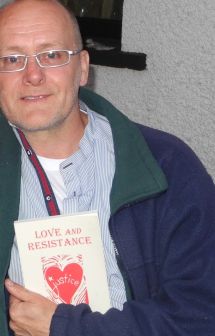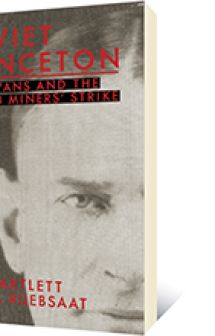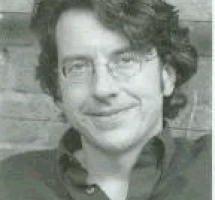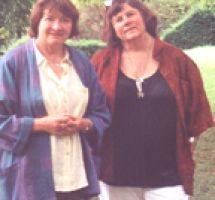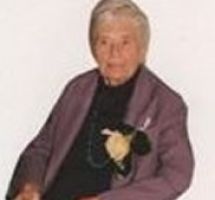
In the introduction to this big and beautiful book by Boullata, a prolific Palestinian artist and writer, the UK artist, John Berger, writes about the absurdity of the identity cards Palestinians are required to carry. He says they have nothing to do with identity; they are an inventory of stolen facts. He goes straight to the heart of Palestinian identity when he writes: True identity can be neither delivered on demand nor stored as mere information. To believe that it can be is weakness of all so–called security records kept by oppressors. True identity is something known in one heart and recognized within another. It always contains a secret tat no interrogation can reveal. Its secret is its human–beingness.
This identity pours out of many Palestinians in creative works – poetry, drama and the visual arts. Now Boullata has created a wonderful illustrated historic collection of Palestinian art and thoughtful reflections that express and illuminate the many Palestinian identities with grace and integrity.
Berger concludes his remarks with: “ this…book…takes the reader close to the struggle of those visionary, obstinate Palestinian artists who create, each in her or his own personal way, so that their anonymous heroic land with its ancestral olive trees may survive.”
In the first part Boullata gives the historical background of visual art in Palestine under Ottoman occupation. Much of the art is photographic (as well photography was quickly accepted in Palestine), pastoral and pictorial. There was also a tradition of Christian iconography and illustration.
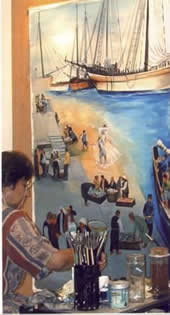
Amam Al-Akhal in her studio painting a scene of Jaffa harbour. Photo © Theresa Wolfwood.
Then the author moves to the next period in history. He writes that: Just as today´s Palestinians who are scattered in separate geographic regions but whose lives continue to share a common destiny with their people wherever they may continue to live, each chapter may be read independently…each section contributes to the making of a homogenous whole. …place is an essential factor that often predisposes the formation of art …In the process the reader finds how proximity and distance from the homeland played a role in moulding the language of expression.
The most important event in Palestinian contemporary history is the NAKBA, the forced exile of 800,000 people from their homeland. They fled to Lebanon, Jordan, Syria and eventually they and their descendents scattered around the world. The Nakba dominates art and life today, both in the diaspora and in the occupied land of today´s Palestine.In 2008, in Amman, I had the privilege of visiting the studio of Tamam Al–Akhal where she showed us her work and that of her late husband, Ismail Shammout. I was emotionally overwhelmed by a room full of brilliant works all depicting the result of the Nakba on their home city of Jaffa. (to learn more about this couple see : Palestine: The exodus and The Odyssey by Isamail and Tamam Shammout. National Press, Amman, Jordan)
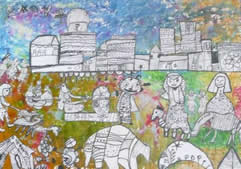
Photos of art from these kindergartens. © Theresa Wolfwood.
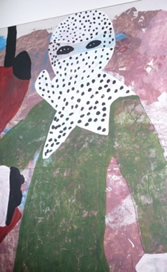
Photos of art from these kindergartens. © Theresa Wolfwood.
Boullata writes in Section II: Memory and Resistance of the importance of keeping memory alive as part of resistance from the outside; visual expression of the memory is so important that it is passed down in kindergartens and schools in permanent refugee communities in Beirut. We saw the art of 3rd generations Palestinians in the kindergartens of the Kanafani Foundation, about the Wall and the Intifada.
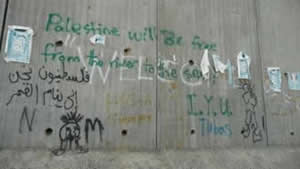
Photo © Theresa Wolfwood.
The art of Naji al–´Ali mainly depicts the life of Palestinians under occupation; he used now famous cartoons to portray the injustices and he sought to shake them {viewers} from the passive stance of mere observer and force them to confront their own predicament vis–à–vis the Palestinian experiences.He was assassinated in London UK in 1987; his cartoon figures are copied everywhere in Palestine – on the Wall and many public surfaces.
Boullata devotes special attention to Palestinian women´s art – once confined to embroidery and domestic arts; women are now prominent in Palestinian art. The most well–known of Palestinian artists outside the region is Mona Hatoum who lives in Europe. We saw one of her bold installations in a gallery in Amman – a barbed wire bed and a clothes hanger in the familiar shape of Palestine.
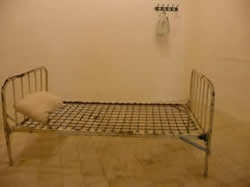
Photo © Theresa Wolfwood.
It is very important to recognize the work of artists who live in ´the interior´ within occupied Palestine. Their art expresses the hardship, the daily harassment and the oppression of their existence. Evocative photographs, stark wood engravings and sketches of the dead and injured are part of their creative reality. Just going from one part of the West Bank to another to attend an exhibition that one is in, is a painful harrowing experience of checkpoints and delays. A one hour journey takes a whole day for pregnant Manal Mahameed.
The author himself has moved into abstraction in ´The Evocation of Place´ He became inspired by the square and he continues… to explore the metamorphosis of the most stable of geometric forms and one that once represented the equilibrium of earth.
This is a very comprehensive work which no one review can really do justice to. It is available and is not expensive for such a well produced art book. Through his writings and the images he uses, Boullata makes it clear that Palestinian art is as strong and as varied as Palestinians are. And this art is an integral part of resistance and the struggle for homeland and self–determination. This is a political book, but then I believe all art is ultimately political.

 Follow
Follow

